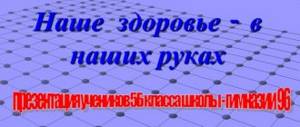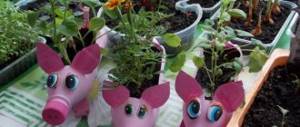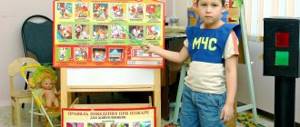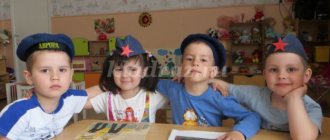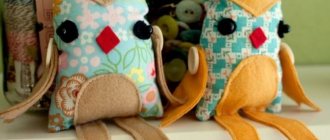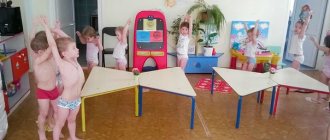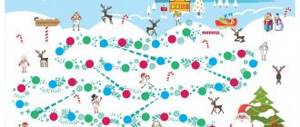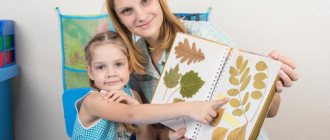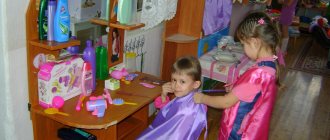Project activities in preschool educational institutions according to Federal State Educational Standards for preschool education
Author: Klyshko Anna Nikolaevna
Project activities in kindergarten according to the Federal State Educational Standard for Education
It should be noted that project activities in preschool educational institutions currently occupy an important place in the activities of teachers. A lot of attention and discussion is devoted to the project activities of preschoolers. When the primary education standard was introduced in 2007, it was the project-based teaching method that was taken as a basis by primary school teachers. For preschool age in preschool educational institutions, the project method can also be considered as one of the most effective forms of organizing joint activities of children and adults. Cognitive and research activities are defined in the Federal State Educational Standard (clause 2.7) as a cross-cutting mechanism for child development.
Project activities in kindergarten according to Federal State Educational Standards
The project method is not a new phenomenon. Look back at history and you'll see that project-based learning was created back in the 1880s. Its essence boiled down to the fact that children, together with the teacher, carry out a joint project of project activities in a preschool educational institution, thus being included in real reality, and not isolated. It was then that 4 types of projects were identified: creative, consumer - this is the production of some items for one’s needs, problematic (solving a problem) and exercise project. This technology was already developed in the 20s of our century by a group of authors as a project method, which was already widely used in Russia in the 30s. Before talking about the project method in preschool educational institutions, it is important to remember that it is always based on the theoretical positions of project activities in preschool educational institutions. The child must be at the core. This means he must be interested. The topics of projects in preschool educational institutions can come not only from an adult, but, first of all, from a child - what he is interested in learning. In addition, for the development of children, the Federal State Educational Standard for preschool education (approved by order of the Ministry of Education and Science of Russia dated October 17, 2013 No. 1155) involves supporting children’s initiative and independence in various types of children’s activities in preschool educational institutions according to the Federal State Educational Standard, including project work.
Project activities in kindergarten according to the Federal State Educational Standard: partnership activities between an adult and preschoolers
When we talk about project activities in preschool educational institutions according to the Federal State Educational Standard, we must remember that in project activities with preschoolers, the position of the teacher changes, and he becomes a partner for the children. Partnership activities between an adult and children should be based on a very meaningful moment: reading fiction, playing, productive activities, cognitive research activities - but the teacher does everything together with the children. You should always pay attention to 4 main positions in which the teacher becomes a partner for the child. 1) The teacher’s involvement in activities on an equal basis with the children. The teacher sits at the table with the children and draws, cuts, and glues together with them. This is not the position of a teacher who showed techniques and stepped aside. 2) The second condition is the child’s voluntary participation in the activity without psychological and disciplinary coercion. There is a teacher’s position: “So-o-o-o, everyone, everyone came up to me! Now you and I are going to build a bridge out of cubes” - such a position should not exist. The teacher must come up with such a turn of phrase in her speech that the preschoolers would want to join the project activity: “Oh, look how big a stream is flowing in our area! Little Mishutka cannot cross. Let's build a bridge together! Who wants to help me? And then, as many children as come, they will build. If the teacher suggests something else, then others will join. 3) The third position is free communication, movement of the child during activities. “Go/take/bring/where is it?/let’s think together...” - this doesn’t have to be at the tables, like at school: kindergarten should gradually move away from the class-lesson system. In recent years, we have sat children at tables; they will sit at desks for another 11 years at school, so project activities for preschoolers should be organized on the floor, if they are interested, and at the table, and bringing children together in another space. By the way, now, during the waking period of children, it is allowed to use bedrooms for organizing play and educational activities, so the space is expanding (finally, SanPiN allowed the use of bedrooms during times when they are not sleeping!) If the beds also move - there are such sets - then there is more space more increases. 4) The fourth position of partnerships (partnership activities of a preschooler) is an open time end to a lesson or game, when everyone works at their own pace. “Individual pace of work on a project” – provides each child with his own level and stages of mastering a particular educational area.
What can be called project activities in kindergarten according to the Federal State Educational Standard?
According to L.V. Svirskaya, “...by project we mean a period of group time, during which both children and adults perform exciting search-cognitive creative work, and not just the participation of children under the guidance of a teacher in a series of activities and games related to one topic "3. She caught the mistake that many teachers make. I would like to remind you that any project must take place in a problematic situation. A problematic situation can be formulated by both an adult, a teacher, and the child himself. He comes and asks: “Why is there rain/wind coming from the sky? Where does it come from? - then this problematic situation unfolds, and the teacher organizes direct activities. Not everything can be called a project; not all topics of project activity in a preschool educational institution are suitable. Not every joint activity of a teacher and children related to a specific topic can be translated into the framework of project activities. For the project, we choose only the situation that cannot be solved by direct action, for example, “I’ll go and read a book about this to them.” The authors of the guide “Project activities for preschoolers” N.E. Veraksa, A.N. Veraksa, outlined the wording: “Project activity involves different forms of children’s activity depending on the plan,” “during project activity in a preschool educational institution, a preschooler explores various options for solving a given problem, and according to certain criteria, chooses the optimal solution path.” The teacher must understand that this is a really difficult process to organize, and not every teacher is ready to organize it. The important point is that participants in project activities in preschool educational institutions should want to know this or be motivated. Here even simple interest is not enough. Teachers often observe how quickly a child’s interest disappears: he asked something and interest disappeared. You need to be able to stir up this interest so that children actively participate and become the authors of ideas - topics for projects in preschool educational institutions. The teacher is included in the study only if all this is thought out step by step.
Topics of project activities in kindergarten according to Federal State Educational Standards
A creative group of senior teachers of family kindergartens summarized the accumulated material and published the book “Organization of project activities in kindergarten”, where you can find excellent projects and ready-made scenarios. For example, the following themes of projects in preschool educational institutions: “Me and my mood”, “Growing up healthy in the Land of Health”, “Family Theater”, “A guest on the doorstep - joy in the house”, “Spoon - the queen of the table”, “Beautiful Christmas tree” etc. Any project in project activities in a preschool educational institution for preschoolers must be created and planned by the teacher in advance. For example, the project “Growing Healthy in the Land of Health” is a research creative project and is long-term in terms of timing. The goal of the project is to provide children with the necessary information to formulate their own strategies and technologies to improve their health and maintain it. During this project, very interesting thematic days were held: “Healthy eating”, “Hygienic rules that you must follow”, “My healthy family” (parents were invited along with their children and a whole literary holiday was created). We recommend that teachers of educational organizations actively introduce project activities of preschoolers into educational activities with children. SanPin 2.4.1.3049–13 “Sanitary and epidemiological requirements for the structure, content and organization of the operating mode of preschool educational organizations,” approved. by Decree of the Chief State Sanitary Doctor of the Russian Federation dated May 15, 2013 No. 26 Lidiya Svirskaya, Candidate of Pedagogical Sciences, Associate Professor of the Department of Theory and Methods of Preschool Education, Novgorod Institute for Educational Development Mikhailova-Svirskaya L.V. The project method in the educational work of kindergarten: a manual for preschool teachers / L.V. Mikhailova-Svirskaya. – M.: Education, 2020. (We work according to the Federal State Educational Standard for preschool education). Veraksa N.E., Veraksa A.N. Project activities for preschoolers. A manual for teachers of preschool institutions. – M.: MOSAIC-SYNTHESIS, 2020.
Basics of implementing project activities for preschoolers
Project activity involves personal forms of activity of children at different stages of the implementation of the plan, so it should be considered outside the traditional network of activities in kindergarten. The project involves carefully thinking through every detail from start to finish in accordance with certain conceptual frameworks. Project activities are based on several theoretical positions: the focus is on the child, not on the topic or conditions; individual pace of work allows each child to reach their own level of success; the assimilation of basic knowledge occurs through their universal use in different situations. The relevance of using project activities is due to the fact that every child has obvious or hidden capabilities, and at every age there are sensitive periods. Children strive to gain new knowledge, to understand the essence of objects and phenomena of the world around them. So, a child can break a just purchased toy to see how it works. And this must be taken into account when organizing project activities. The basis of any project is to provide the child with the opportunity to be a researcher, transformer, and experimenter. At the same time, conditions must be created in which he receives satisfaction from his activities. There are three main types of project activities: creative, research, normative.
Research project activities of preschoolers
The purpose of research project activity is to obtain answers to the questions: “Why does this phenomenon exist?”, “How can it be explained?” During project activities, the child not only assimilates what the teacher tells him, but turns into a researcher, while the teacher creates conditions in which the child himself receives an answer to his question. Research project activities of preschoolers are often individual in nature and involve the involvement of the child’s immediate environment (family, friends) in his area of interest. Such a study can be carried out with a small subgroup and involves certain stages. During the first stage, a situation is created in which the child has the question: “What do I want to know?” The second stage involves the active involvement of the child in project activities, conducting experiments, etc. The third stage is the defense of the project, during which the child demonstrates the results of his work and shows how he understood the topic. At the final fourth stage, the teacher offers various tasks, intellectual games to systematize and consolidate the material, and organizes an exhibition.
T creative project activities for preschoolers
The peculiarity of a creative project is that, as a rule, it is long-term and collective in nature. Each child can come up with their own idea, and all children do part of the overall work with a collective result. Creative project activities of preschoolers can also be divided into several stages. The first stage is preparation, discussion, choice of topic. At the second stage, the choice of motives for children’s participation occurs, because not all children in the group can participate in the project. The third stage involves children expressing ideas regarding the implementation of the project, discussing the progress of work, and making sketches. This stage is the most difficult for preschool children, since you need to be able to communicate correctly, justify and prove your position. Here the teacher cannot take sides, but must allow the children to independently come to a common position. This will help overcome egocentrism and reach a new level of communicative and intellectual development. The fourth stage is the implementation of the plan through joint efforts. At the fifth stage, a presentation takes place; not all children participate in it, but a part that represents the result of collective work.
Normative project activities of preschoolers
Normative projects assume that children themselves create a system of rules and norms of behavior in a group or kindergarten.
They determine how to behave in the washroom, locker room, etc. Such projects are aimed at solving educational problems, but are implemented by children. When a child enters kindergarten, there are already a number of rules, among which three groups can be distinguished: prohibitive; positively normative; supporting the child’s initiative to create a new norm. What are the stages of normative project activity of preschoolers? At the first stage, the teacher defines situations, or even initiates behavior options, and shows what consequences may arise. That is, conversations are held on ethical topics. Here it is appropriate to recall the conversations and classes of Durova N.V. At the second stage, the teacher asks to model undesirable consequences. The third stage is a discussion of the rules, as a result of which a book or album with rules appears. An example would be the projects “How to behave while playing,” “How to use scissors,” etc. Such projects can be implemented in all age groups. When implementing project activities for preschoolers, the teacher should not speed up the transition to the practical part. Some projects may take several days or weeks. In this case, you can involve not only a group of children, but also involve parents. For example, the project “Pedigree of my family”, “Family reading”, “Family theater”, “Hospitality: a guest on the doorstep - joy in the house”, etc. To summarize, it can be noted that the relevance of project activities is due to the fact that it allows one to expand the social and cognitive space of children, develop their creative activity, general intellectual abilities, and form cognitive motivation. Therefore, project activities must be included in the educational program as often as it is appropriate and convenient. comments powered by HyperComments
MAGAZINE Preschooler.RF
Consultation for educators “Structure and design of the project” + memo for educators “Technological map of the project”Municipal autonomous preschool educational institution “Kindergarten No. 8”, Kungur
Consultation for teachers “STRUCTURE AND DESIGN OF THE PROJECT”
Prepared by: 1st category teacher Padukova N.V. 2020
The project method is an innovative educational technology aimed at developing children’s independent activities in order to obtain a certain result.
The project method can be represented as a way of organizing the educational process, based on the interaction between teacher and student, a way of interaction with the environment, and step-by-step practical activities to achieve a set goal. The main goal of the project method in preschool institutions is the development of the free creative personality of the child.
The project method is relevant and very effective. It gives the child the opportunity to experiment, synthesize acquired knowledge, develop creativity and communication skills, which allows him to successfully adapt to the changing situation of modern education.
Types of projects in preschool educational institutions:
Creative: after the project is brought to life, the result is formalized in the form of a children's party.
Research: children conduct experiments, after which the results are presented in the form of newspapers, books, albums, and exhibitions.
Game projects: these are projects with elements of creative games, when children take on the role of fairy tale characters, solving problems and tasks in their own way.
Informational: children collect information and implement it, focusing on their own social interests (design of a group, individual corners, etc.).
Role-playing: (children enter the image of the characters in the fairy tale and solve the problems posed in their own way);
PROJECT STRUCTURE
- Title page
- Project topic
- Project type
- Participants
- Terms by duration
short-term (1-3 weeks);
medium duration (up to 1 month);
long-term (up to 1 year);
6. Relevance. Statement of the problem (explains why there was a need to complete the project, why children, teachers, and preschool institutions need this project)
7. Project goal (must be clear, specific, realistic)
8. Objectives (specific steps to achieve the goal; what, how and where can change, how it will be measured, what audience the project is aimed at, etc.)
9. Stages of work
This section consists of 3 stages:
Stage I – preliminary: monitoring children’s knowledge, questioning parents, studying literature, preparing material, etc.
Stage II – main: There must be a schedule of activities (activities within the project)
The organization of work on the project is described. The section should make it clear who will carry out the actions and how, and in what sequence. It must be stated how the result is planned to be achieved. Date, event, person in charge.
Stage III – final: summing up the work on the project.
At this stage, final events are planned: educational activities, entertainment, quizzes, competitions.
10. Expected results (what needs to be obtained to complete the assigned tasks, quantitative and qualitative results)
11. Literature
12. Evaluation of results and reporting, analysis.
This section should make it clear whether the project will achieve its objectives and how the results will be monitored.
13. Applications
The appendix may include material that was covered within the framework of the project (summaries of joint activities with children, plans for entertainment, conversations with children, scenarios for events, questionnaires for parents,)
The project method is relevant and very effective. It gives the child the opportunity to experiment, synthesize the acquisition of knowledge, develop creativity and communication skills, which allows him to successfully adapt to the changed situation of modern education.
It’s very easy to remember that a project is the 5 Ps :
- Problem;
- Search for information;
- Design or planning;
- Product;
- Presentation.
| Next > |
Short-term project in the preparatory group.
Municipal budgetary preschool educational institution
Kindergarten "Firefly"
Short-term project in preparatory group No. 2 “Let's save nature together”
Completed by: Savelyeva O.V.
Semikarakorsk 2020
“Nature for us is a storehouse of the sun with great treasures. And protecting nature means protecting the Motherland.” M. M. Prishvin. Relevance
project:
Nature is an amazing phenomenon, the educational impact of which on the spiritual world of a preschool child can hardly be overestimated. Nature is the source of the first concrete knowledge and joyful experiences, often remembered for a lifetime. A child's soul is revealed in communication with nature, interest in the world around him is awakened, and the ability to make discoveries and be surprised by them is formed. It's no secret that preschool children are explorers by nature. .
An unquenchable thirst for new experiences, curiosity, a constant desire to experiment, and independently seek new information about the world are traditionally considered as the most important features of children's behavior.
Research, search activity is the natural state of a child, he is determined to understand the world, he wants to know it. To explore, discover, study means to take a step into the unknown and unknown. It is exploratory behavior that creates the conditions for the child’s mental development to initially unfold as a process of self-development. Of particular importance for the development of a preschooler’s personality is his assimilation of ideas about the relationship between nature and man. Mastering the methods of practical interaction with the environment ensures the formation of a child’s worldview and his personal growth. A significant role in this direction is played by the search and cognitive activity of preschool children, which takes place in the form of experimental actions. Preschool age is an important stage in the development of human ecological culture. During this period, the foundations of personality are laid, including a positive attitude towards nature and
the surrounding world.
At this age, the child begins to distinguish himself from the environment, an emotional and value-based attitude to the environment develops, and the foundations of the moral and ecological positions of the individual are formed, which are manifested in the child’s interactions with nature, in the awareness of inseparability with it. Thanks to this, it is possible for children to develop environmental knowledge, norms and rules for interacting with nature, develop empathy for it, and be active in solving some environmental problems. Kindergarten is the first link in the system of continuous environmental education, so it is no coincidence that teachers are faced with the task of forming the foundations of a culture of rational environmental management among preschoolers .
Project type: research, practice-oriented. Duration: short term.
Project participants: training groups, teachers, parents. Objective of the project :
Formation of a conscious and moral attitude towards nature in children of senior preschool age and their parents. Project objectives :
1. Foster love and respect for all life on Earth, develop an aesthetic perception of nature.
2. Involve children and parents in a variety of activities in nature and its protection.
3. Develop skills of environmentally literate, moral behavior in nature.
4.Ensure continuity of environmental education in the system: preschool educational institution - family.
5. To develop in children a cognitive interest in the life of animals in nature,
observation, creative imagination.
6. Foster an ecological culture and respect for nature in children and adults.
7. To form in children a caring, responsible, emotionally friendly attitude towards the natural world,
to living beings, in the process of communicating with them.
Stages of work:
Stage 1 - preparatory
: goals and objectives, determination of directions, objects and methods of research, preliminary work with teachers, children and their parents, selection of equipment and materials, study of programmatic and methodological material in the field of work,
Stage 2 - practical:
actually research: searching for answers to the questions posed in different ways. Excursions around the kindergarten, events, observations on a walk to develop environmental literacy of pupils, conducting educational activities in accordance with the long-term work plan).
Reading fiction and looking at illustrations help
consolidate and clarify children’s ideas gained through direct perception of natural objects. V. Zotov “White Hare”, “Forest Mosaic”, V. Charushin “What kind of animal”, N. Sladkov “Forest rustles”, L. Tolstoy “Wolf”, A. Klykov “How a fox spends the winter”, K. Ushinsky “Bunny’s complaints”, “Fox Patrikeevna”, G. Snegirev “Our animals forests”, N. Pavlova “White Fur Coats” (from the book “The Four Seasons”). Environmental conversation
:"Towards nature with kindness"
“Forest is the most important component of the biosphere”;
"Value of the forest";
“The forest is nature’s storehouse”;
"Our smaller brothers." Operation Help Nature.
The goal is to clean certain corners of nature from debris, help trees and insects.
Operation Gift to the Birds.
The goal is to make feeders with the help of parents and hang them on the territory of the kindergarten.
Quiz "Do we know the plants of our region."
Excursion along an ecological path - fix the names of trees, notice changes in nature, in the appearance of trees and grasses, from autumn to spring.
Handmade with natural materials “Gifts of Autumn”.
Exhibition of children's works and joint works with parents.
Making birdhouses with the help of parents. Growing a vegetable garden on a window:
Onions, dill, peas, cucumbers. Flowers. On a walk :
outdoor games
Guess whose tail” “Who lives where?” “Hares and the Hunter” “Sly Fox” “Wolf in the Ditch” “Who knows, let him continue” “Guess whose trail.” Observations:
Behind the beauty of nature, behind changes in nature, behind birds and insects, behind inanimate objects and phenomena in nature: snow, rain, fog..; ECOLOGICAL MYSTERIES
What a wonderful beauty! Painted gates appeared on the way! You can’t drive into them, You can’t enter them. Answer (Rainbow) In the blue sky, White sheep float like along a river. They keep their way from afar. What are their names? ...Answer (Clouds)
Across the sky, bags with holes run like a horde, and sometimes water flows from the bags. Let's hide better From the leaky one... Answer (Clouds) There is a shirt on the street, In the hut there are sleeves. Answer (Sunbeam) You warm the whole world And you don’t know fatigue, You smile in the window, And everyone calls you... Answer (Sun) Blue scarf, scarlet bun, Rolls on the scarf, smiles at people. Answer (Sky, sun) What kind of ceiling is this? Sometimes he is low, sometimes he is tall, sometimes he is gray, sometimes he is whitish, sometimes he is a little bluish. And sometimes so beautiful - Lace and blue-blue! Answer (Sky) At night there is one Golden orange in the sky. Two weeks passed, We didn’t eat any orange, But only an orange slice remained in the sky. Answer (Moon, month) At night I walk across the sky, dimly illuminating the earth. I’m very bored alone, And my name is... Answer (Moon) I ran along the meadow path - The poppies nodded their heads. He ran along the blue river - the river became pockmarked. Answer (Wind) It wets the field, forest and meadow, the city, the house and everything around! He is the leader of the clouds and clouds, You know, this is... Answer (Rain) Flowers fall on the trees, on the bushes from the sky. White, fluffy, but not fragrant. Answer (Snow) What are those carved stars on the coat and on the scarf? Everything is through, cut out, and if you take it, there is water in your hand. Answer (Snowflakes) Whose drawings are on the window, Like the pattern on the crystal? The Winter Grandfather pinches everyone's nose... Answer (Frost) The wind blew and the frost brought us snow from the north. Only ever since then, on my glass... Answer (Pattern) Not snow, not ice, But it will remove the trees with silver. Answer (Rime)
Stage 3 - final:
consolidation of acquired knowledge, formulation of conclusions by children. Generalization of the results of work on the environmental project “Let's save nature together”
During the implementation of the project the following results were achieved:
Basic ecological knowledge and a culture of behavior in nature were formed; Children began to understand the interconnections in nature, began to treat it more carefully, animals, birds, insects; There was an interest in natural phenomena and objects. Strengthened the ability to experiment, analyze and draw conclusions; The environmental culture of parents has improved; they have become more attentive to environmental issues.
Conditions have been created for conducting experimental activities. Experience in developing conscious, environmentally literate behavior in nature in children. A developed sense of empathy and desire to help natural objects. The album “Animals of our region” has been compiled. Feeders and birdhouses for birds were made.
The work being carried out is quite effective, efficient and determines the direction of further work and environmental activities.
Poems about ecology for children
Protect the environment!
So that you can feel the joy of tomorrow, the Earth must be clean and the sky must be clean.
And this Earth, without sparing, Tormented century after century And the “Reasonable” man took everything only for himself.
Now we rushed to save the “Natural Environment”, But why did we sense trouble so late?
Through the smoke of factories and factories, It is difficult for us to see All the suffering that the Earth has to endure!
How long will we have enough water, if there is poison dissolved in it? How long will those forests last, where the axes are knocking?
Save fields, forests, meadows And the clean expanse of rivers - the whole Earth - Only you, a Reasonable Man, can!
Birdie
She flew over the highway.
The driver did not brake, and the poor bird fell under a heavily loaded ZIL. If she had taken it a little higher, she would have saved herself: Not only was she just above the roof, she could have flown over the forest! The May evening was quiet and bright, Nightingales sang in the lilacs. And this incident was not noted by the local traffic police officer. (S. Mikhalkov) Cherry
On a clear afternoon, at the end of summer, an old man walked along the road;
I dug up a young cherry tree somewhere and, satisfied, carried it home. He looked with cheerful eyes at the fields, at the distant boundary, and thought: “Let me plant a cherry tree by the road as a souvenir. Let the big one grow, let it go both in breadth and height, And, decorating our road, bathe in bloom every year. Travelers will lie down in its shade, rest in the coolness, in silence, and, having tasted the juicy, ripe berries, maybe they will remember me. If they don’t remember, what a shame, I don’t worry about it at all: If they don’t want to, don’t remember, don’t, I’ll plant a cherry tree anyway! At the city cleanup
At the city cleanup, Excellent workers.
To clean up the city today, both young and old have come. Pensioners gathered to clean the streets and squares. – Do you need helpers? Suggestions are heard. This is the third grade, going out to clean for the first time. All you can hear is: “Come on!” Get to work! Someone is collecting garbage, someone is planting trees, someone is pottering around in the flower beds, joyful faces are everywhere. At the city cleanup, all the janitors, all the rafts. Even the restless mayor came to our park to help. No one quarrels with anyone, Everyone’s work is going smoothly. The third grade decided to clean up the city for the holiday. (N. Anishina) Appeal of a tree to a Man
- Hey, Man, I am a TREE!
High, mighty! I’m still standing in the forest And rustling for now. The entire timber industry can't wait for the opportunity to knock me down, cut me down, cut me down - Look for the fool! Just let him try! I want to warn her in advance in a friendly way, the Minister - including: Whatever they make of me - all efforts are in vain! I look peaceful while I'm standing in the ground. But just turn me into various products - I will suddenly creak in the night like a closet with wild horror! I will bury myself as a stool splinter in your body! I’ll rot like a parquet under you - Even if you fall, even if you scream! I'll accidentally go down the toilet with three months' salary! I’ll collapse with a table on the guests, including the Minister... Isn’t it easier than cutting me down, Take it straight away and hang yourself? You don’t have to look for the rope - it lies in the hollow! (I. Shevchuk) Walk
We came to the river to spend Sunday, But we couldn’t find a free place near the river! They sit here and sit there: Sunbathe and eat, Relax as they want, Hundreds of adults and children! We walked along the bank and found a clearing. But in the sunny clearing, here and there - empty cans And, as if to spite us, even broken glass! We walked along the bank and found a new place. But they sat here before us too; They also drank, they also ate, they lit a fire, they burned paper - they littered and left! Of course, we passed by... - Hey, guys! - Dima shouted. - This is a great place! Spring water! Wonderful view! Beautiful beach! Unpack your luggage! We swam, sunbathed, lit a fire, played football - had as much fun as we could! We drank kvass, ate canned food, sang choir songs... We rested and left! And we remained in the clearing By the extinguished fire: Two bottles we broke, Two soggy bagels - In a word, a mountain of garbage! We came to the river to spend Monday, but we couldn’t find a clean place near the river! (S. Mikhalkov)
Even though the grass won't grow
There are fewer and fewer untouched places on the planet. Lakes of oil are spilled across the tundra. And hostile whirlwinds swirl from the pipes... Wildlife is already half a corpse. The man brought her to her knees. The deer are moving further and further north... We want to rake in more money. And what after us? AT LEAST THE GRASS DOESN'T GROW. (A. Usachev)
Promotion – with the distribution of leaflets “We sort waste correctly”
Growing a vegetable garden on a window.
Cleaning the flower beds.
Making a poster: “Animals in our forest”
Exhibition of feeders.
Caring for plants in preschool educational institutions.
Methodological recommendationsPedagogical project: development, implementation, result
Having been an expert in the certification of teaching staff for many years, I am faced with a problem in the development and execution of pedagogical projects for kindergarten teachers, so I want to share a model for writing a pedagogical project, which is a methodological development for writing it. I hope that it will be useful in your work.
1. Title page.
- Full name of the educational institution
- Project name
- By dominant activity: (game, cognitive, creative,
research, practice-oriented).
- By number of participants: ( group, collective, pair, individual)
- Nature of contacts: (among children of one group, among children of several groups, among children of a preschool educational institution).
- By duration: - short-term (1 or several lessons - 1-2 weeks); - medium-term (1 or 2 weeks-month);
- long-term (1 month-six months and beyond).
- Applicant: children (age group).
- Author of the project: position Full name
- 20... year
2. Project structure.
- Problem : describes the problem affected by this project.
- Relevance
of the topic:
The formulation of the problem will go to the goal of the project . (Methodology by Svetenko T.V. “Mirror of innovative transformations in practice”)
| problem | target |
| No idea what a mother is needed for | Give an idea about mom, her importance and necessity, why she is needed |
| causes | tasks |
|
|
(problem, goal setting – organizational stage)
We develop a project using the “three questions” technique:
| What do we know? | All the answers given by the children |
| What do we want to know? | |
| How do we find out? |
(a general discussion is held with the children and all the children’s answers are recorded, after all the children have spoken, the teacher asks the question “How can we find answers to the questions?” - organizational stage.
- Project goal
:
the expected result of the activity, expressed in positive changes in (teacher) children resulting from the implementation of the project.
- Project objectives: actions or steps to achieve intermediate results aimed at achieving the goal.
3. Project stages.
1.
Organizational.
1. Teacher (educator) - reveals the problem.
2. Teacher - defines the goal, outlines tasks for achieving the goal.
3. Children - joining the project.
4. Parents - evoke a positive response from parents to the existing problem.
2.
Activity planning.
1. Teacher - production of manuals for the project;
- conversations ( for example, about geometric figures);
- conversations ( for example, about flowers);
— making games; selection of available games;
- learning through didactic, active, finger games, poems, riddles,
— thinking through practical, experimental activities;
- productive activity.
- reading books, contacting parents, specialists, conducting experiments, thematic excursions, recreating an object or event, classes, etc.
2. Children - learning games, poems, participating in experimental and productive activities, searching with parents and teachers for new knowledge about what is being studied.
3. Parents - we are looking for information, working on creating a developmental environment for the group (according to the instructions of the teachers), making newspapers, leaflets, essays, etc. with the children..
3.
Final
- Expected Result
- product
| result | product |
| What you can hold in your hands:
|
| What results are you hoping for? | What will be the product of your project? |
| Results of diagnostics, questionnaires, express surveys, etc. |
|
4. Project web.
By educational area. (For example)
| Health. Relaxation P/anthem. Logorithm. control Medical physical " Rhythmoplasty, etc. | Physical Culture. | Safety. |
| Socialization. | Subject…. Main event….. | Artistic creativity. |
| Cognition. | Communication. | Reading art literature. |
| Work. | Music. | Developmental environment. |
5. Project implementation plan. (main stage)
| Regime moments | Collaboration between teacher and children | Collaboration between parents and children | Free creative activity of children |
| 1. 2. |
| 1. 2. | 1. 2. |
(The final stage)
6. Expected result:
Criteria for assessing diagnostic results……
(you write down the specific knowledge and skills of children that you want to gain as a result of working on the project and, in accordance with this, set the levels of development: high, medium, low).
Short……
Average…..
High…..
7. Project product:
8. Diagnostics of children at the beginning of work on the project.
| Child's full name | Knowledge of 8 colors | Knowledge of 8 forms | Etc. |
| Ivanov V. | IN | WITH |
Diagnostics of children at the end of the project.
| Child's full name | Knowledge of 8 colors | Knowledge of 8 forms | Etc. |
| Ivanov V. | IN | WITH |
9. Presentation of the project.
Usually, at the end of the project theme, some bright event
or a common cause that provides children with the opportunity to demonstrate the knowledge and skills acquired during the project, as well as express their emotional attitude to what happened before and what is happening at the moment - this is a presentation.
10. Reflection.
- Answers to the question “What have we learned?” (after finishing the project) let the teacher understand what the children have learned.
- Analyzing individual lessons allows you to improve future projects. The teacher must answer the following questions: “Which part of the project was the most successful? What should you change next time? What did the children learn? What didn't work? Why?"
- The results of each project are discussed with the group:
—Have you learned anything new?
— Did you learn anything that surprised you?
—Which of the activities did you like the most?
Reflection on the topic of the project is organized not only with children. but also with teachers. The teacher must answer the questions:
What events in the topic turned out to be the most successful and effective for achieving the goals?
What should you change or consider next time?
What worked, what didn’t and why?
(Answers to the questions asked are described).
11. Forecast of possible negative consequences and ways to correct them.
| Negative consequences | Correction methods |
I wish you all success in your teaching career!
Bibliography:
1. Sypchenko E.A. Innovative pedagogical technologies. Method of projects in preschool educational institutions. - St. Petersburg: LLC PUBLISHING HOUSE "CHILDHOOD - PRESS", 2012
2. Pedagogical design. Collection of results of the Regional competition “Pedagogical Project”, Tomsk, 2011
Lesson on cognitive and research activities in kindergarten
Cognitive and research activity is one of the spontaneous manifestations of a child’s curiosity. This quality of an inquisitive mind must be actively involved in a variety of classes: studying the surrounding world, productive (drawing, modeling, designing), preparing for literacy, etc. Exclusively research activities occupy a small part in the educational process, sometimes they are separated into club activities (work in mini-laboratories, experimental workshops). The teacher should practice conducting integrated classes in which work is carried out in several directions (“artistic and aesthetic development”, “cognitive activity”, “labor activity”, etc.), paying maximum attention to the formation and improvement of research skills when studying by children objects and phenomena of the surrounding world.
After directly studying the vegetables, the children can draw them
Table: card index of topics for educational and research activities
| Research topic | Tasks | Age group |
| "Water and its properties" |
| Junior |
| "Magic Sponges" |
| Junior |
| "Lemon" | Formation of the ability to conduct research in various ways: visual, olfactory, kinetic. | Junior |
| “I'm a researcher. Stone" |
| Junior |
| “Why did the snowman melt?” |
| Average |
| "Milk" |
| Average |
| "Lost and found" |
| Average |
| "Amazing Ball" | Formation of ideas about the properties of rubber in the process of research activities. | Average |
| "Merry vegetable garden" | Expanding knowledge about cultivated plants and methods of growing them. | Average |
| "Energy. Current runs through the wires" |
| Older |
| "The Amazing Magnet" |
| Older |
| "Pillow" | Development of the ability to compare, generalize and draw conclusions (using the example of studying pillows with various fillings - synthetic winterizer, cotton wool, fluff, buckwheat husk, straw). | Older |
| "Volcano" | Improving the ability to work with various materials and substances during the experiment. | Older |
| "Worms" |
| Older |
| "Salt" | Formation of ideas about the properties of salt (including salt water) and their use in production and everyday life. | Preparatory |
| "Thermometer" |
| Preparatory |
| "The Diver from Komarovo" | Formation of ideas about the floating of bodies, air pressure and liquids. | Preparatory |
| "Human Pupil" | Acquaintance with the properties of the pupil to expand and contract depending on lighting. | Preparatory |
Table: lesson notes on cognitive and research activities in the senior group (fragment)
| Author | Zakharova E., teacher of MBDOU D/s No. 8 “Cheburashka”, Belaya Kalitva, Rostov region. |
| Subject | "Volcano" |
| Target | Introduce children to a natural phenomenon - a volcano. |
| Tasks |
|
| Materials |
|
| Progress of the lesson | Motivation. V.: Guys, today the postman brought us a parcel. Are you interested in knowing what's in it? (They open it, there is pumice there). Who knows what this is? What is the name of? What is it for? Maybe someone has such an item at home? (Children's answers). Preschoolers examine pumice and compare it with the rocks already available in the experimentation corner: coal, chalk, sandstone. V.: There is also a note in the parcel, and there is a hint in it, listen:
But this object does not look like a volcano at all. This hint did not help us, but, on the contrary, confused us. Guys, are you interested in knowing what this item is? Then we will try to find out. We will also find out what a volcano is and how it is connected to the mystery object. The teacher tells the children a legend about the volcano. <…> V.: Now do you want to see what a real volcano looks like? (Children's answers). Our computer will help us. (Show slides with different types of volcanoes: “sleeping”, “waking up”, “boiling”, erupting). Volcanoes erupt in different ways. Sometimes they seem to explode, throwing magma up and to the sides. A huge mountain shakes with a terrible roar, a huge cloud of smoke and ash rises above it, and stone rain showers the slopes. And sometimes it flows out “calmly.” What does a volcano look like? (A volcano is a large mountain with steep sides). What shape is the volcano? (Cone). At the very top of the volcano there is a crater. The crater is a huge bowl with steep slopes, and at the bottom there is a reddish-orange mouth, this is the mouth of a volcano, a hole going deep into the ground. The fiery liquid coming out of a volcano is called lava. Interesting? Do you want to see a volcanic eruption? I suggest you do an experiment: a volcanic eruption. Where can you do experiments? (In the laboratory). I suggest you go to our laboratory of “interesting discoveries” (they go to tables with volcano models prepared in advance and all the necessary components for the experiment). In our laboratory, everything is ready to conduct experiments. What will we make the base of the volcano from? (From the cone). What is a volcano's mouth made of? (A plastic cup). All this is on a tray. Before you begin the experiment, you need to study the diagram. (The teacher, together with the children, discusses the sequence of the experiment.)
What are you observing? Watch your volcano erupt. It erupts calmly. <…> Guys, can we show a volcanic eruption? Shall we try? Sketch “The volcano wakes up and erupts.” V.: Guys, you and I did the “Volcanic Eruption” experiment, and I told you the legend about the volcano, and we learned the structure of the volcano, and even depicted the volcano ourselves... But they forgot a little about our mysterious object, what it is after all ? Maybe someone figured it out after all? (Children's answers). And if we don’t know something, who or where can we find out? (Encyclopedia, reference book, on the Internet). Do we have an encyclopedia in the library? Let's see if there is an answer to our question. We open it and read: this is pumice - frozen volcanic lava. Used to remove dirt from hands or rough skin from heels. Questions for reflection:
V.: I’m glad that you really liked it, and you were so attentive, active, inquisitive, great fellows! |
| Quote from: https://www.maam.ru/detskijsad/konspekt-zanjatija-poznavatelno-isledovatelskaja-dejatelnost-vulkan-starshaja-grupa.html | |
Lesson time plan
The duration of educational classes in kindergarten depends on the age of the students and is determined by SanPiN standards:
- junior group - 15 minutes;
- middle group - 20 minutes;
- senior group - 25 minutes;
- preparatory group - 30 minutes.
In the middle of the lesson, physical education or an active game should be carried out as a means of preventing overwork.
Since cognitive-research activities require mental effort, they should be conducted in the first half of the day, preferably on Tuesday or Wednesday - days of high performance.
Table: time plan for the lesson “Visiting the Paper Fairy” in the younger group
| Structural component of the lesson | Motivating start (surprise moment) | Didactic game | Physical education minute | Study of paper properties | Summarizing |
| Time spending | 2 minutes | 2–3 minutes | 1–2 minutes | 7 minutes | 1–2 minutes |
Table: time plan for the lesson “Journey to the World of Water” in the middle group
| Structural component of the lesson | Motivating start (creating a game situation, solving riddles) | Didactic game | Outdoor game | Studying the properties of water (conducting experiments) | Summarizing |
| Time spending | 2–3 minutes | 3 minutes | 3 minutes | 10 minutes | 1–2 minutes |
Table: time plan for a lesson during a walk “Why do icicles cry?” in the senior group
| Structural component of the lesson | Motivating beginning (reading and discussion of a didactic fairy tale) | Charging outdoors | Research (observation of icicles in the shade and in the sun) | Work assignments | Conducting an experiment with ice floes | Summarizing |
| Time spending | 3–4 minutes | 5 minutes | 10 minutes | 5–7 minutes | 4 minutes | 2 minutes |
Table: time plan for the lesson “What is a rainbow?” in the preparatory group
| Structural component of the lesson | Motivating beginning (surprise moment, problematic situation, watching a video) | Heuristic conversation | Outdoor game | Didactic game | Studying the conditions for the appearance of a rainbow (conducting an experiment) | Summarizing |
| Time spending | 3 minutes | 3–5 minutes | 3–4 minutes | 3 minutes | 12–14 minutes | 1–2 minutes |
